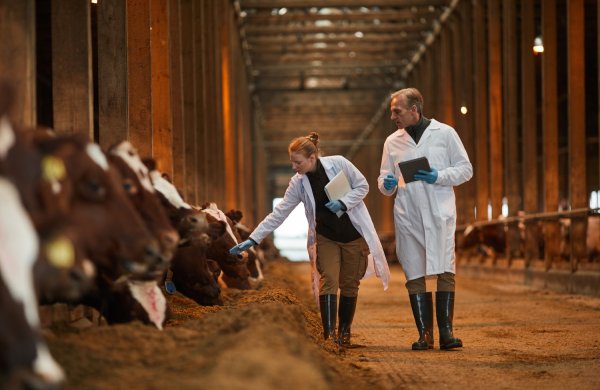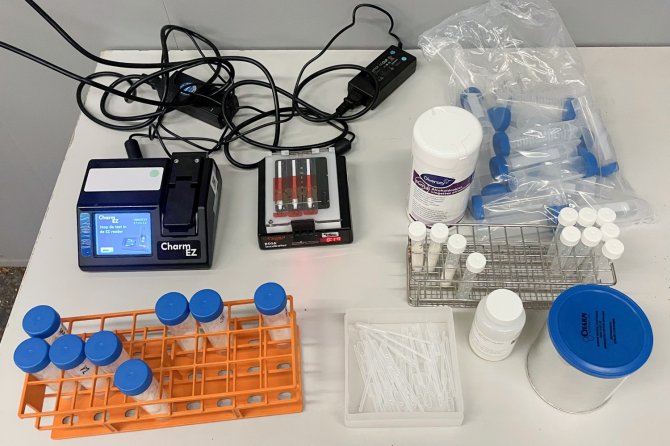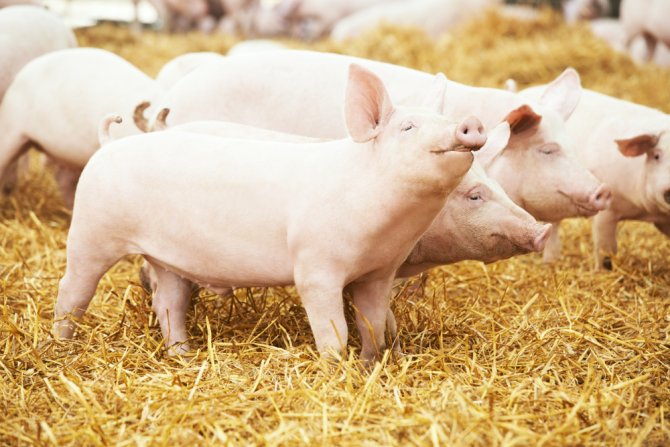
Longread
A rapid test to monitor antibiotic use in livestock farming
Antibiotics must be used with restraint if we are to prevent the emergence of resistant bacteria, and that applies to livestock farming, too. This is why farmers keep a record of the amount of antibiotics they use. Currently, however, these records are checked slow and expensive laboratory tests. Scientists at Wageningen are developing a rapid test which will give immediate results. It’s efficient, but can be confronting.
“The use of antibiotics in animal products and in animals themselves is monitored in the Netherlands,” says Dr Bjorn Berendsen, programme leader and senior researcher at Wageningen Food Safety Research (WFSR). “The purpose of that monitoring process is to safeguard human health. Naturally, we want to minimise any traces of antibiotics in our food. More importantly, however, we don't want the bacteria in livestock to become resistant to those antibiotics. After all, that would render our strongest weapon against infectious diseases useless. That’s why livestock farmers need to be careful with antibiotics and record how much they use.”
Inspectors from the Netherlands Food and Consumer Product Safety Authority (NVWA) take random samples to see if livestock farmers are correctly registering their use of antibiotics. This specific part of the process is where Berendsen and his colleagues think there are gains to be made. At present, an expensive laboratory test is the only way to show whether livestock have been treated with antibiotics. However, the rapid test being developed by the scientists will enable an inspector to instantly see whether an animal has received unregistered treatment.
Test based on a chicken feather
Limiting the use of antibiotics in livestock farming is important, because humans will inevitably come into contact with bacteria in the animals. “If you live on a livestock farm and you’re admitted to hospital, you’re automatically placed in an isolation ward. That’s why we need to prevent the emergence of resistance,” explains Berendsen.

And that’s also why the NVWA monitors the quantity of antibiotics used by livestock farmers. WFSR conducts tests annually on meat and milk, but that’s not enough to get a comprehensive picture. If an animal received a course of antibiotics more than a few weeks before slaughter, it wouldn’t be detected in their meat or milk. That’s why the WUR researchers teamed up with the NVWA to go and look at the live animals in the context of antibiotic registration. Might there be a test that could register antibiotic use throughout the lifespan of the animal?
The rapid tests come in a plastic casing, similar to the ones we know from the pandemic
The scientists found that such a test did exist: mass spectrometry. This enabled the researchers to identify traces of antibiotics at the molecular level. It even worked with dead material, such as a chicken feather. “We could trace pretty much all the treatments that a broiler chicken had received throughout its life.”
Slow laboratory tests
The major disadvantage of mass spectrometry is that it’s a laboratory test with a turnaround time of two to three days. “Cost efficiency dictates that you first collect as many samples as possible so you can analyse them all at once,” says Berendsen. “So in practice, it can take weeks or months before you get the results of a sample.”
That long turnaround time makes such sampling rather ineffective. If a farmer has used more antibiotics than they’ve registered, it will take a long time before this comes to light. “Such a farmer would have had ample opportunity to cover their tracks before any follow-up investigations take place. Everything would be neat and tidy by then, and any leftover antibiotics disposed of.” And the inspector would therefore be too late. It would be much better if an inspector could determine whether any follow-up investigation is needed on the spot, and to then also do that immediately.
- Unfortunately, your cookie settings do not allow videos to be displayed. - check your settings
Berendsen stresses that most farmers already carefully observe the rules anyway. Most of the expensive laboratory analyses are negative. “Yes, that does cost money.”
Analysing results with an app
Berendsen and his colleagues have now developed a rapid test. He shows us a strip of paper that looks a bit like a pH test from a chemistry lab. “These go into a plastic casing, which makes them look like the self-tests we’re all familiar with from the pandemic.” The rapid antibiotic tests check for several antibiotics at once. “Preferably as many as possible, of course, but the test does need to be clearly legible. Each antibiotic has its own dash. We’re looking into the possibility of using dots instead. That way, we could fit even more tests onto a single strip.”
Of course, it’s important that all inspectors get the same results. “To a certain extent, that will come down to training, but we’re also thinking about an app for inspectors to use on their smartphones.” The idea, Berendsen explains, is that inspectors would take a picture of the strip, and then an application would disclose the test results. This would significantly reduce the likelihood of errors.
Confronting results
“We’re not trying to catch more farmers red-handed,” Berendsen says. “On the contrary: I think getting an immediate result actually has a strong preventative effect.” Berendsen speaks from experience. One farmer was somewhat affronted by an experiment with the rapid test. “We showed him the results and said, ‘look: in the second barn, you administered a treatment using penicillin’. It was a confronting issue for him. ‘I did actually observe the waiting period,’ he said. ‘I followed the rules.’” We really had to explain that we could see a record of the entire treatment history of the animal. And his administrative records were, in fact, perfectly fine.”
Berendsen knows that not all farmers have the same reaction. Another livestock farmer who participated in the study revealed in advance which antibiotic the test would find. However, the scientists discovered traces of an additional substance. “They showed this to the farmer. At first, he just laughed a bit. He had indeed administered both antibiotics and had carefully registered them, too, but he just wanted to see if we really could detect everything. Fortunately, we could.”
Rapid test in practice
NVWA inspector interviewed
NVWA inspector Martin van de Veen tried the rapid tests during the WFSR study. He rubbed ethanol wipes on the backs of a number of veal calves and dairy cows. In addition, he took samples from the feed fence and the mixing vat, which he used to perform the tests. Three questions for Van der Veen:
1. What are your thoughts on the use of rapid tests now you’ve experienced them in practice?
Rubbing a wipe over the back of a cow, a wiping sample, is a lot easier to perform than the conventional methods. Shaving off hair can be quite a hassle, especially when it comes to large steers. Collecting urine often takes a while. This process was faster and easier, although working with a pipette and the device was quite finicky. I think this can be resolved through practice and some practical improvements. I am positive about this test. The antibiotics we found exactly matched what was registered in the livestock farmer’s administration.
2. How can these tests be usefully applied in practice?
Our conclusion: if you don’t find any antibiotics when testing a certain number of cows, ten, for instance, through random sampling, you possibly won’t have to perform any further investigations. In case of a positive test, you can take an additional hair and/or urine sample. This is because a positive test might call the evidence into question. After all, how do the antibiotics end up on the back of a cow? Did this originate from a different cow in the barn or a different cow during transport? You only perform further investigations if the test is positive. This will save time and money, as fewer samples will need to be collected and processed.
3. How will the communication with the farmer change?
Right now, farmers sometimes have to wait several months for the results of a urine or hair test. That can create quite a lot of stress, so it’s far more pleasant for farmers to receive the results of the test right away. That way, the checks for that part can be concluded immediately.

The test isn’t ready to be put into general use just yet. “It’s obviously a big change for the inspectors, and there are also scientific questions we still want answers to,” says Berendsen. Those questions mainly relate to how traces of antibiotics spread through a barn. This is because the sample for the test is taken from the skin of an animal. If that gives a positive result, is it safe to conclude that the animal in question has had the treatment, or could animals also pass those traces on to each other? Could they be airborne? “We’re still researching that at the moment.”
There are still scientific questions about how traces of antibiotics spread through a barn
Berendsen also thinks there are other sectors that could benefit from access to a rapid test. “For example, we’re also looking at the import of animal feed at the port of Rotterdam. A test like this would be very effective for detecting the most important fungi or other toxins.” A rapid test is already being used in the floriculture sector to test for the use of pesticides associated with bee mortality. “When you’ve got a container in a harbour, or a shipment of flowers, you want to be able to release it as soon as possible. A rapid test is a good solution for that.”